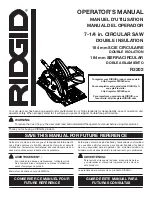
11 - English
OPERATION
WARNING:
To avoid possible serious injury, never use saw when
guard is not operating correctly. Check the guard
for correct operation before each use. The guard
is operating correctly when it moves freely, and
instantly returns to the closed position. If you drop
the saw, check the lower blade guard and bumper
for damage at all depth settings before reuse.
WARNING:
Never tie the lower blade guard in a raised position.
Leaving the blade exposed could lead to serious
injury.
If at any time the lower blade guard does not snap closed,
unplug the saw from the power supply. Exercise the lower
guard by moving it rapidly back and forth from the full open
position to the closed position several times. Normally this
will restore the guard to its normal operating condition. If
it does not correct a slow or sluggish closing lower guard,
do not use the saw. Take it to an authorized factory service
center for repair.
STARTING/STOPPING THE SAW
See Figure 9, page 18.
To start the saw:
Depress the switch trigger.
Always let the blade reach full speed, then guide the saw
into the workpiece.
WARNING:
The blade coming in contact with the workpiece
before it reaches full speed could cause the saw to
“kickback” towards you resulting in serious injury.
To stop the saw:
Release the switch trigger.
After you release the switch trigger, allow the blade to come
to a complete stop.
Do not remove the saw from the
workpiece while the blade is moving.
ADJUSTING BLADE DEPTH
See Figure 10, page 18.
Always keep correct blade depth setting. Less than a
full tooth of the blade teeth should be visible below the
workpiece. More blade depth will increase the chance of
kickback and cause the cut to be rough.
Unplug the saw.
Pull depth adjustment lever upward to release.
Determine the desired depth of cut.
Hold base flat against the workpiece and raise or lower
saw until the index point or mark on the saw aligns with
the desired depth on the scale.
Push down on depth adjustment lever to lock into position.
INDEXABLE LEVERS
See Figure 11, page 18.
The levers on the saw can be repositioned for the best
tightening position.
Pull the lever out from the saw and to desired position.
Push lever back in and down to lock into place.
Check to be sure the base is clamped securely.
OPERATING THE SAW
See Figures 12 - 14, page 18.
It is important to understand the correct method for operating
the saw. Refer to the figures in this section to learn the correct
and incorrect ways for handling the saw.
WARNING:
To make sawing easier and safer, always maintain
proper control of the saw. Loss of control could
cause an accident resulting in possible serious
injury.
DANGER:
When lifting the saw from the workpiece, the blade
is exposed on the underside of the saw until the
lower blade guard closes. Make sure the lower
blade guard is closed before setting the saw down.
To make the best possible cut, follow these helpful hints.
Hold the saw firmly with both hands.
Avoid placing your hand on the workpiece while making
a cut.
Support the workpiece so that the cut (kerf) is always to
your side.
Support the workpiece near the cut.
Clamp the workpiece securely so that the workpiece will
not move during the cut.
Always place the saw on the workpiece that is supported,
not the “cut off” piece.
Place the workpiece with the “good” side down.
Draw a guideline along the desired line of cut before
beginning the cut.
Keep the cord away from the cutting area. Always place
the cord to prevent it from hanging up on the workpiece
while making a cut.
WARNING:
If the cord hangs up on the workpiece during a
cut, release the switch trigger immediately. Unplug
the saw and reposition the cord to prevent it from
hanging up again.












































